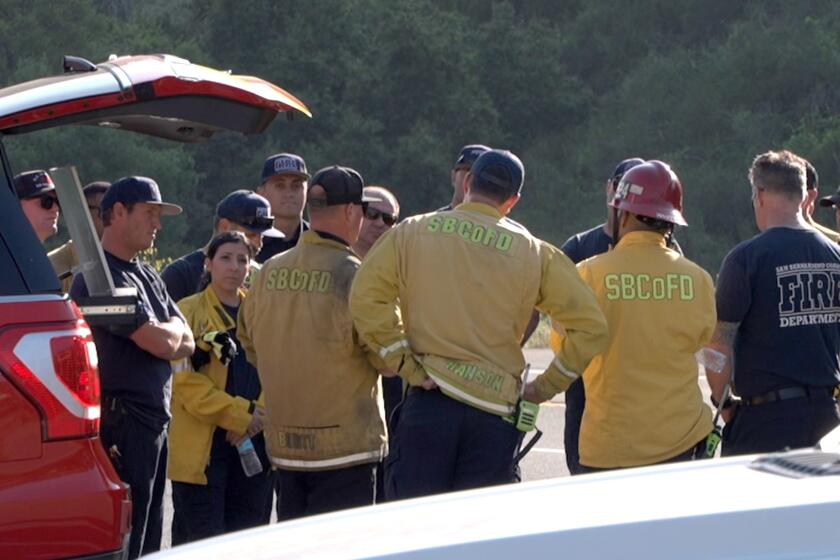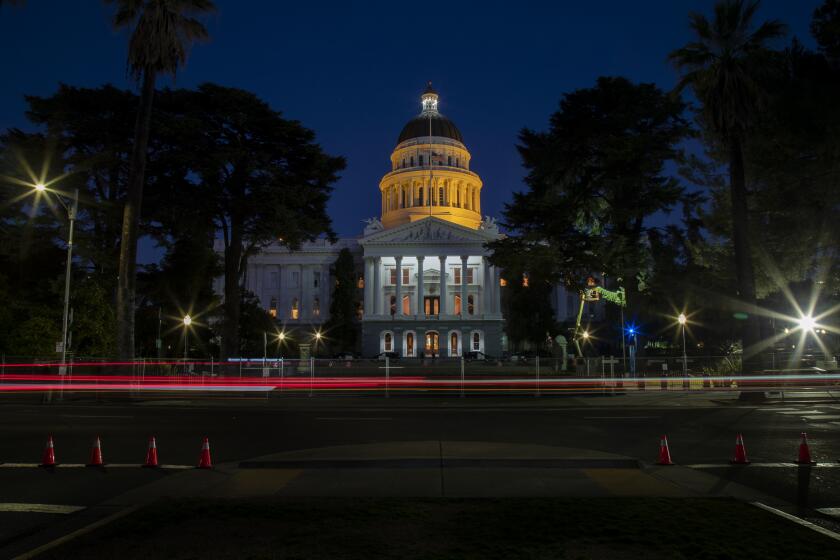Sewage Woes Threaten to Soil Laguna’s Good Name
Concerned about a rash of sewage spills that have closed beaches five times this year, Laguna Beach officials are moving toward upgrading the city’s sewage pump stations by installing backup generators and electronic warning systems.
At stake, officials say, is the city’s reputation as a progressive, clean arts colony and a popular spot for thousands of summer tourists.
“We’re most noted for the arts and small-town charm,” Councilman Dan Kenney said. “Sewage is not what I want Laguna Beach to be known for.”
Laguna’s problem, like many seaside cities in the South County, is its outdated sewer system and steep terrain that requires sewage to be pumped uphill to one of 23 city stations, increasing the possibility of leaks.
Power Failures Blamed
Although most spills this year have been caused by broken sewer pipes, 10 of the 14 leaks in the past two years have been attributed to power failures and similar problems, according to city records.
“The combination of these two things is very precarious,” Mayor Robert F. Gentry said.
The largest of the spills this year came June 22, when 900,000 gallons of raw sewage spewed into the Aliso Beach surf, forcing the popular beach to be closed for almost a week. Another spill came on July 23, when 12,000 gallons of sewage flowed into the surf between Legion and Thalia streets, again closing that city beach. The other spills came in the winter off-season.
Laguna Beach has reserve generators and warning systems at two of its pump stations, said city engineer Russ Cox. Warning systems at the 21 others would cost $575,000, Cox said. The city might not be able to afford generators at every station, he said.
Kenney, who has brought the issue to the City Council, said the city will look at the capacity of each station and determine which ones need safeguards.
“We need to move into the modern era,” Kenney said.
Warning System
The mayor agreed the city needs a warning system.
“Up to now, you have to physically see it (sewage), and it has to be reported,” he said. “By then, it’s too late.”
Sewage spills in the Laguna Beach area have been responsible for five of seven beach closures in Orange County so far this year, said Robert E. Merryman, the county’s director of environmental health.
But not all spills were caused by sewage problems within the city limits. Spills in water districts outside Laguna Beach, such as the one that closed most of Aliso Beach for nearly a week after a break in the South Coast Water District lines, find their way to Laguna’s shoreline.
“That’s the price we have to pay for living on the water,” Kenney said.
Currents and tides eventually carry the sewage to sea. But for at least two days, county health officials must check water samples for contamination that could cause hepatitis or other bacterial diseases.
Cox said the July 23 spill was caused by a power outage at eight stations. He said the city is working on a system with Southern California Edison Co. that would immediately notify Laguna Beach of outages.
Other systems in the county don’t have such problems.
Treatment plants in Fountain Valley and Huntington Beach operated by the Orange County Sanitation Districts, for instance, can operate stations without electricity. The districts serve 80% of north Orange County.
Gentry said the public grows weary of reading about the spills.
“What we don’t know is how it’s affected casual daytime tourists to beaches,” he said. “People are going to go elsewhere.”
LAGUNA BEACH SEWAGE SPILLS
Fourteen times over the last two years, sewage has spilled into the Pacific Ocean in the Laguna Beach area. Ten spills were caused by power failures or related problems. Of those, four closed beaches to the public.
July 10, 1987--Power-pole fire at Cleo Street pump station forces power outage, causing sewage to leak into surf for eight hours.
July 16--Broken power line at Anita Street station causes two-hour sewage leak.
Oct. 19--Broken power line at Pearl Street station causes sewage to flow into water for more than five hours.
Dec. 3--Power failure at Cleo Street station causes two-hour spill.
Dec. 13--Power outages at four stations cause small spills.
May 21, 1988--Portions of Main Beach closed after failure of pump station causes 1 million gallons of raw sewage to flow into ocean.
July 12--Portions of Main Beach closed after failure of backup pump causes about 36,000 gallons of raw sewage to spew into water.
July 24--Power outage at Cleo Street station causes sewage to flow into surf for six hours, closing strip of Main Beach.
Aug. 29--Burned transformer at Victoria Street station causes small spill.
Jan. 16, 1989--Strip of Aliso Beach closed after broken sewage pipe spews 175,000 gallons of raw sewage into ocean.
Jan. 31--One-mile stretch of Aliso Beach closed after construction crew accidentally breaks sewer pipe, spilling 60,000 gallons into ocean.
March--Sewer line erupts, spilling 100,000 gallons into surf and closing portion of Aliso Beach.
June 22--900,000 gallons of raw sewage leak into ocean from broken sewer pipe, closing Aliso Beach for five days.
July 23--Power outages cause pump failures at eight stations, causing sewage leaks at three stations: 12,000 gallons from Cleo Street, 500 gallons from Irvine Cove and 10 gallons from McKnight Drive. Main Beach closed.
Sources: city of Laguna Beach, Times news reports.
More to Read
Start your day right
Sign up for Essential California for news, features and recommendations from the L.A. Times and beyond in your inbox six days a week.
You may occasionally receive promotional content from the Los Angeles Times.






